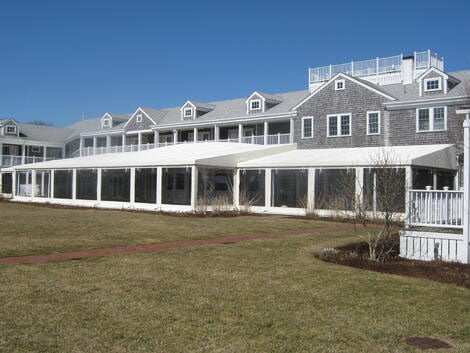 Awnings are an important energy and money saving structure that most homes should have. Awnings save energy and can reduce temperatures by 8-15 degrees. Awnings can also reduce air conditioning costs up to 25 percent! And most importantly, awnings protect your family and your home from sun damage and ultra violet rays.
Awnings are an important energy and money saving structure that most homes should have. Awnings save energy and can reduce temperatures by 8-15 degrees. Awnings can also reduce air conditioning costs up to 25 percent! And most importantly, awnings protect your family and your home from sun damage and ultra violet rays.
Awning fabrics come in all shapes, sizes, and materials. Choosing the right material involves more than just looking at your budget. The type of material you use can save you in the long run. Some of the materials awning fabrics are made of include: Vinyl, Acrylic, Polyester Vinyl Composite, Metal, and other natural materials.
So what material is best for your awning? It all depends on what you’re looking for. Here’s a quick rundown of some of the most common materials used in awning fabrics today:
Vinyl and Polyester Composite fabrics offer durability and are water proof. The vinyl fabric stays tight on the frame and is inherently fire retardant. The material is light and flexible. The composite offers versatility and flexibility for both residential and commercial applications.
Acrylic fabrics are more durable than traditional cotton blend canvas. Awnings made with acrylic fabrics offer an appealing design element and repel water but they should not be considered water proof. Acrylic fabric awnings are great for homes located in humid areas; they resist mildew and ultraviolet light wear and tear.
Some awning fabrics are coated with vinyl. Vinyl awnings are more translucent and can be heavy as well. They are also good at resisting mildew and ultraviolet light.
Some applications may choose metal awnings which offer very high durability. However metal awnings need a lot of overall maintenance to help prevent rust and can be easily damaged. Metal awnings are heavier and more costly. In the summer they can act as a heat magnet. There is good architectural appeal but they are less versatile than traditional fabric awnings.
Finally, awnings made from natural materials like wood and canvas can be used as well. Natural materials are cheaper but can be easily damaged and fall apart. Natural fiber awnings need to be replaced more often than their acrylic or vinyl, or vinyl polyester composite counterparts.
If you’re looking for a durable water proof and fire resistant awning fabric that is energy efficient, then a vinyl polyester composite fabric might be right for you. Luckily, Herculite Products offers a variety of quality awning materials and products that fit your budget and your home.
Herculite manufactures vinyl and polyester composite awnings that are flexible, fire resistant, waterproof, mildew and stain resistant, and easy to clean.
One other thing to consider when purchasing an awning is the ability of your manufacturer to provide specifications that fit your project and your budget. Herculite does just that and offers custom engineered fabric products specified to your needs.
Remember, a good awning can save you on energy costs, reduce sun damage to your home and furnishings and protect your family.
To learn more about awning fabrics, download our free guide, "Five Factors to Consider when Determining a Quality Awning Fabric"
